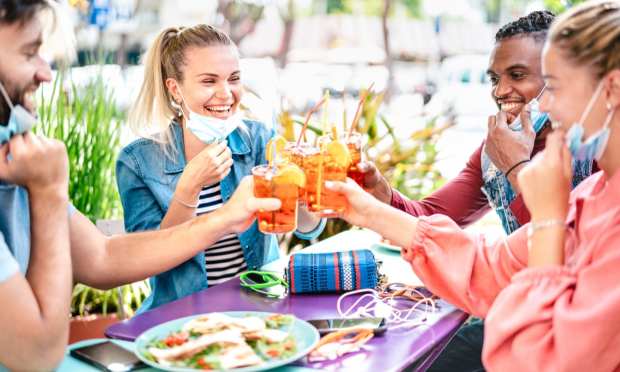With Vaccinations And Stimulus Checks, Is Table Service Dining Back?

In-restaurant table service is on its way back. Flynn Restaurant Group, Applebee’s largest franchisee with 444 units, told Bloomberg in a recent interview that the restaurant chain is seeing a sharp increase in sales, which the firm believes to be the result of “stimulus checks, enhanced unemployment and tax rebates.”
“I’m seeing some of the strongest sales I’ve ever seen in my career,” Greg Flynn, the restaurant group’s CEO, said in an interview with the news outlet. “People are finally getting vaccinated, spring is here. There’s a light at the end of a tunnel. The rules are all relaxing. People are getting out and they have money in their pockets.”
His observations mirror those of Gene Lee, the CEO of Darden Restaurants, parent company of several casual dining giants including Olive Garden and Longhorn Steakhouse, on a call with analysts on Thursday (March 25). As he said, “You know, it’s amazing — people get their vaccination, the first thing they do is they go to a restaurant, even though they probably should wait a few days.”
It is no surprise that consumers are eager to get back to restaurant dining, although it may be somewhat surprising how quickly the return is happening. A PYMNTS survey of over 2,000 U.S. consumers found that 61 percent are interested in eating out in restaurants more often than they currently do. This share is even higher than the 57 percent of consumers who are at least somewhat interested in leaving home more often than they are currently able to. As Flynn noted, the start of this return may be super charged by the latest round of stimulus checks, with restaurant meals being among the first purchases consumers make when they receive these payments.
Lee noted that restaurants’ first returners tend to be older. “We’re noticing, especially near vaccination sites, that this is their [consumers’] time out in a year, and they’re just so excited to be back,” he said, noting, “some larger groups of senior citizens … are just happy to be back out … there’s a good vibe in our restaurants right now.”
This trend of older consumers returning first may not be exclusively because of the vaccine — PYMNTS research has found that older consumers are also the most eager to return to on-site dining. Some 68 percent of baby boomers and seniors and 56 percent of Generation X consumers indicated a desire to dine out more often, compared to only 44 percent of millennials and Generation Z consumers.
Though the resurgence of in-restaurant table service marks a return to the familiar, the indoor dining experience may be permanently altered by the events of the past year. Olo CEO Noah Glass recently predicted in an interview with Karen Webster that order-ahead technologies will shift the in-restaurant experience toward speed and convenience.
“We’ve always imagined that, at some point in the future, consumers would want the ability to make a reservation and order at the same time or be waiting for a table to open up and place an order at the same time,” Glass said. “I feel like we’re getting pulled into that sort of opportunity as restaurants reopen. It’s really by restaurants with limited capacity and also the family dining segment … saying, ‘My business lives and dies by Saturday and Sunday morning. I need to turn those tables quickly.’”
Meanwhile, Noodles & Company CEO Dave Boennighausen predicted in an interview with Webster that restaurants will have “fewer areas within a restaurant where you could see any kind of communal contact.” One of the more dramatic changes this will include, compared to pre-COVID dining, is that plexiglass partitions will remain a part of the restaurant experience “for the next year or two.” So yes, with vaccinations and stimulus checks, we may see consumers returning to enjoy indoor dining experience, but this indicates less of a “back to normal” and more of an opportunity to establish a new normal.
